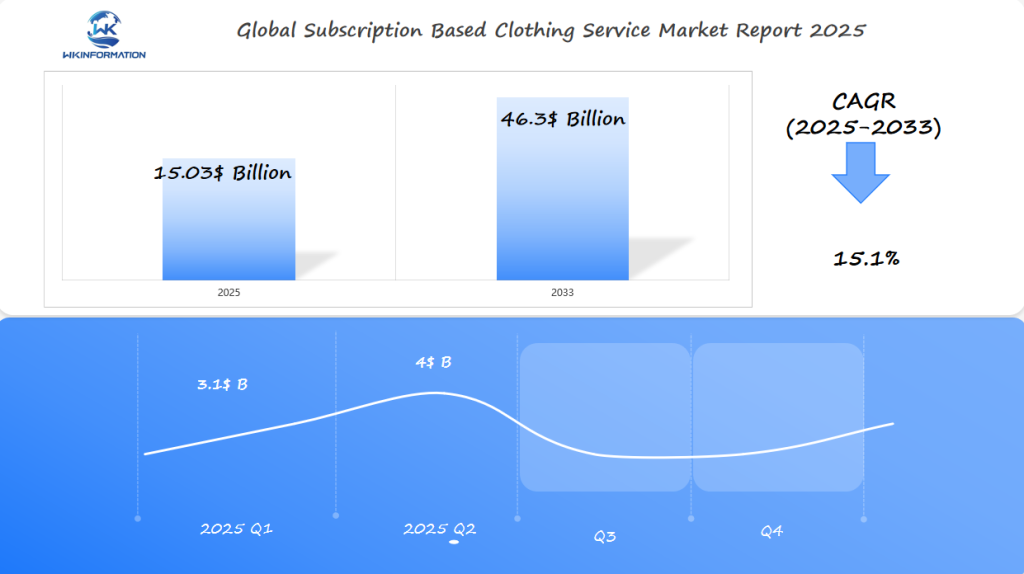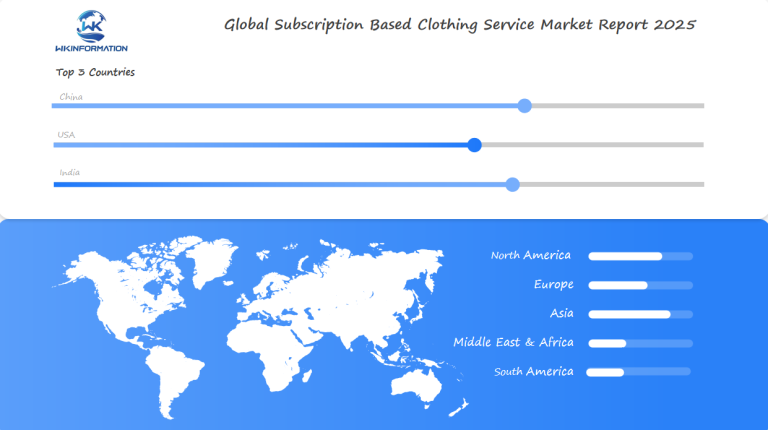Subscription Based Clothing Service Market Set to Expand to $15.03 Billion Globally by 2025: Growth Centers in the U.S., Canada, and Australia
Discover the growing Subscription Based Clothing Service Market, projected to reach $15.03 Billion globally by 2025.
- Last Updated:
Subscription Based Clothing Service Market Q1 and Q2 2025 Performance Insights
The Subscription Based Clothing Service market is expected to reach $15.03 billion by the end of 2025, with a strong annual growth rate of 15.1% during the forecast period from 2025 to 2033. In the first half of 2025, the market is projected to generate approximately $3.1 billion in Q1 and $4.0 billion in Q2. The sharper growth in Q2 can be attributed to seasonal fashion trends, including spring/summer wardrobe renewals and promotional subscription campaigns typically launched around this time.
The United States, Canada, and Australia are identified as the major driving regions:
- In the U.S., the cultural shift toward personalized, convenient shopping experiences continues to bolster subscription service adoption.
- Canadian consumers, increasingly focused on sustainable fashion and hassle-free solutions, are fueling a steady uptick.
- Meanwhile, Australia’s appetite for flexible clothing options, especially in its growing e-commerce sector, is supporting a notable expansion in the market.
These trends collectively indicate a strong momentum through mid-2025.

Upstream and Downstream Industry Chain of the Subscription Based Clothing Service Market
The Subscription Based Clothing Service Market is intricately linked with its industry chain, which plays a vital role in its expansion. The industry chain involves various stakeholders, from clothing manufacturers and suppliers to logistics providers and customer service operators.
Understanding the Industry Chain
The industry chain of the Subscription Based Clothing Service Market can be broadly categorized into upstream and downstream components.
Upstream Components
The upstream segment includes clothing production and sourcing, where manufacturers and suppliers play a crucial role. They are responsible for producing high-quality clothing that meets consumer demands. Key components of the upstream segment include:
- Clothing production
- Sourcing raw materials
- Supply chain management
Downstream Components
The downstream segment encompasses marketing, distribution, and customer service. Effective marketing strategies and efficient distribution networks are essential for the success of clothing rental services. Customer service is also critical, as it directly impacts customer satisfaction and retention. Key components of the downstream segment include:
- Marketing and advertising
- Distribution and logistics
- Customer service and support
According to industry experts, “A well-coordinated industry chain is essential for the Subscription Based Clothing Service Market to thrive.” This emphasizes the importance of understanding and optimizing both upstream and downstream components.
The clothing rental service industry has seen significant growth, driven by increasing consumer demand for sustainable and affordable fashion. The fashion rental market is becoming increasingly competitive, with companies focusing on improving their industry chain to gain a competitive edge.
By understanding the industry chain and its various components, businesses in the Subscription Based Clothing Service Market can identify areas for improvement and optimize their operations to drive growth.
Shifting Trends Transforming the Subscription Based Clothing Service Market
The apparel subscription box market is undergoing a significant change with the introduction of personalization and sustainability. This transformation is being driven by changing consumer preferences and advancements in technology.
Emerging Trends in Clothing Subscription Services
Several emerging trends are transforming the clothing subscription service industry. One key trend is the use of AI-driven styling to offer consumers a tailored experience. Services are also adopting eco-friendly packaging and promoting recyclable clothing to align with consumer values on sustainability.
Personalization and Sustainability
The demand for personalization is leading companies to leverage data analytics and AI to understand consumer preferences better. This enables them to curate clothing selections that closely match individual tastes and needs.
On the other hand, sustainability is becoming a critical factor, with consumers increasingly preferring services that adopt environmentally friendly practices. This includes using recyclable materials, reducing waste, and promoting the reuse of clothing items.
| Trend | Description | Impact |
| Personalization | Use of AI and data analytics to tailor clothing selections | Increased consumer satisfaction and loyalty |
| Sustainability | Adoption of eco-friendly packaging and recyclable clothing | Enhanced brand reputation and appeal to environmentally conscious consumers |
| Technological Integration | Incorporation of AI, AR, and VR to enhance consumer experience | Improved engagement and reduced return rates |
As these trends continue to evolve, the subscription-based clothing service market is likely to see further innovations that cater to the changing needs and preferences of consumers.
Key Constraints Facing the Subscription Based Clothing Service Market
The Subscription Based Clothing Service Market is experiencing significant growth, but several factors are hindering its progress. Several key constraints are impacting the growth of the Subscription Based Clothing Service Market.
One of the primary challenges is the high operational costs associated with managing inventory, logistics, and customer service. Companies must balance these costs while maintaining profitability.
Challenges in the Clothing Rental Service Industry
The clothing rental service industry faces unique challenges, including logistical complexities and consumer concerns about clothing quality and hygiene. To overcome these challenges, businesses are focusing on improving their supply chain efficiency and enhancing customer experience.
Some of the key challenges faced by the industry include:
- Managing inventory and logistics effectively
- Addressing consumer concerns about clothing quality and hygiene
- Maintaining profitability while keeping costs low
As Emily Chen, CEO of a leading clothing rental service, notes, “The key to success lies in understanding consumer needs and preferences, and adapting our services accordingly.” This approach enables companies to provide high-quality services that meet consumer expectations.
To navigate these challenges, companies are adopting strategies such as:
- Investing in customer service and support
- Enhancing the overall user experience through technology and personalized services
- Improving supply chain efficiency to reduce costs and improve quality
By understanding and addressing these key constraints, businesses in the Subscription Based Clothing Service Market can overcome the challenges and capitalize on the growth opportunities in this evolving market.

Geopolitical Shifts Influencing the Subscription Based Clothing Service Ecosystem
Geopolitical events are reshaping the landscape of the clothing subscription industry. The complex interplay of global economic policies, trade agreements, and socio-political changes is significantly impacting the market dynamics.
The subscription-based clothing service market is not immune to the effects of geopolitical shifts. Events such as Brexit and the COVID-19 pandemic have underscored the need for companies to be agile and responsive to changing circumstances. As a result, businesses are adapting their strategies to navigate the uncertainties of the global market.
Impact of Global Events on the Clothing Subscription Market
Global events have a significant impact on the clothing subscription market. For example, the COVID-19 pandemic accelerated the shift towards sustainable fashion subscription services as consumers became more environmentally conscious. Additionally, trade policies and economic sanctions have influenced the supply chain and distribution networks of clothing rental services.
The table below highlights some key geopolitical events and their potential impact on the clothing subscription market:
| Geopolitical Event | Impact on Supply Chain | Impact on Consumer Behavior |
| Trade Wars | Disruption in global supply chains, increased costs | Shift towards local sourcing, increased price sensitivity |
| Economic Sanctions | Restrictions on imports/exports, supply chain rerouting | Changes in consumer spending habits, preference for sustainable products |
| Global Pandemics | Lockdowns,production halts, logistical challenges | Increased demand for contactless services, focus on health and sustainability |
The shift towards sustainable fashion subscription services is also being driven by geopolitical factors, as governments implement policies to reduce environmental impact. This trend is expected to continue as consumers become more aware of the environmental and social implications of their purchasing decisions.
The clothing subscription market is being shaped by a complex array of geopolitical factors. Companies that are able to adapt to these changes and prioritize sustainability are likely to thrive in this evolving landscape.
Type-Based Growth Opportunities in the Subscription Based Clothing Service Market
Various clothing categories are creating type-based growth opportunities in the Subscription Based Clothing Service Market. The market is experiencing a significant change as consumers increasingly prefer subscription services that cater to their specific needs.
The demand for women’s clothing subscription services is on the rise, driven by the convenience and personalized styling they offer. Similarly, men’s clothing subscription services are gaining popularity, providing men with tailored apparel options that fit their lifestyle and preferences.
Opportunities in Different Clothing Categories
The Subscription Based Clothing Service Market is segmented into various clothing categories, each presenting unique growth opportunities. Women’s clothing remains a dominant segment, with services offering curated selections of apparel based on individuals’ preferences.
Men’s clothing subscription services are also emerging as a significant segment, with companies offering personalized styling and convenience. The growth in these segments is driven by the increasing demand for hassle-free, stylish clothing options.
| Clothing Category | Growth Opportunities | Key Drivers |
| Women’s Clothing | Personalized styling, curated selections | Convenience, fashion trends |
| Men’s Clothing | Tailored apparel, subscription convenience | Lifestyle preferences, ease of use |
By understanding the unique opportunities in different clothing categories, businesses can tailor their services to meet the specific needs of their target audience, driving growth in the Subscription Based Clothing Service Market.
Understanding Consumer Demand in the Subscription-Based Clothing Service Market
Application insights reveal that consumer demand in the subscription-based clothing service market is driven by various factors. Understanding these demand patterns is crucial for businesses to tailor their services effectively. This understanding can be further enhanced by analyzing how retail spending varies by household income, which is a significant aspect of consumer behavior.
Understanding Consumer Demand
Consumer demand in the subscription-based clothing service market is influenced by the desire for convenience, variety, and personalized styling. For instance, clothing subscription services for women have gained popularity due to their ability to offer tailored clothing options based on individual preferences.
The demand patterns in this market can be analyzed through various application insights, including:
- Consumer behavior and preferences
- Purchase history and feedback
- Demographic data and trends
By examining these insights, businesses can identify trends and preferences, enabling them to make informed decisions about their services.
| Demand Pattern | Consumer Preference | Business Response |
| Convenience | Easy returns and exchanges | Implement hassle-free return policies |
| Variety | Access to diverse clothing options | Offer a wide range of clothing categories |
| Personalized Styling | Tailored clothing recommendations | Use AI-driven styling services |
Understanding consumer demand patterns through application insights is vital for businesses in the subscription-based clothing service market. By analyzing these insights, companies can develop targeted strategies to meet consumer needs and stay competitive in the market.
Regional Developments and Global Spread of Subscription Based Clothing Services
Regional developments are playing a crucial role in the global spread of subscription-based clothing services, with various markets exhibiting unique growth patterns. The subscription-based clothing service market is becoming increasingly global, with different regions contributing to its expansion.
The growth of these services is driven by factors such as increasing consumer awareness, advancements in technology, and the rising demand for sustainable fashion. As a result, businesses are focusing on regional market analysis to understand consumer preferences and tailor their services accordingly.
Market Analysis by Region
The regional market analysis reveals diverse trends and consumer behaviors across different parts of the world. For instance, in North America, the market is driven by a strong demand for convenience and affordability, while in Europe, there’s a significant focus on sustainability and eco-friendly practices.
The Asia-Pacific region is emerging as a significant growth opportunity, driven by increasing adoption of online shopping and a rising middle class with disposable income.
A detailed examination of the regional developments in the subscription-based clothing service market highlights the importance of understanding local consumer preferences and adapting business strategies to meet these needs.
- The North American market is characterized by a high level of competition and a strong emphasis on customer service.
- The European market is driven by sustainability concerns and regulatory compliance.
- The Asia-Pacific region offers significant growth opportunities due to its large and growing consumer base.

U.S. Subscription Based Clothing Service Market Dynamics and Insights
Consumer demand for convenience and personalized clothing services is driving the U.S. subscription-based clothing market forward. This trend is supported by a well-established e-commerce infrastructure that facilitates easy access to various clothing services.
Market Trends in the United States
The U.S. market is witnessing a significant shift towards niche clothing subscription services that cater to specific consumer needs, such as plus-size clothing, maternity wear, and outdoor gear. These niche services are gaining popularity as they offer a more personalized shopping experience.
Another key trend is the increasing importance of sustainability in the clothing industry. Consumers are becoming more environmentally conscious, and subscription-based services are responding by incorporating eco-friendly practices into their business models.
Key Trends in the U.S. Subscription-Based Clothing Service Market
- Rise of niche clothing subscription services
- Growing demand for sustainable clothing options
- Increased use of technology for personalized services
To remain competitive, companies operating in the U.S. subscription-based clothing service market must stay abreast of these trends. This includes investing in technology to enhance the consumer experience and adopting sustainable practices to appeal to the environmentally conscious consumer.
Canada’s Emerging Subscription-Based Clothing Service Market
As consumers increasingly seek out convenient and affordable fashion options, Canada’s subscription-based clothing service market is emerging as a significant growth opportunity. This trend is driven by a growing demand for clothing rental and subscription services, particularly among women who value the flexibility and variety offered by these services.
Growth Opportunities in Canada
The Canadian market presents numerous growth opportunities for companies offering subscription-based clothing services. Tailored services that cater to the specific needs and preferences of Canadian consumers are likely to gain traction. For instance, services that offer personalized styling options and flexible subscription plans can attract a loyal customer base.
Key growth drivers in Canada include the increasing popularity of online shopping, a growing awareness of sustainable fashion, and a rising demand for women’s clothing subscription services. Companies can capitalize on these trends by offering services that are not only convenient and affordable but also sustainable and tailored to the needs of Canadian women.
Potential Growth Strategies
To effectively tap into Canada’s emerging subscription-based clothing service market, businesses can consider the following strategies:
- Expanding customer base through targeted marketing campaigns
- Enhancing service offerings with personalized options
- Building strategic partnerships with local brands and retailers
By focusing on these strategies, businesses can effectively tap into Canada’s emerging subscription-based clothing service market and establish a strong presence in this growing industry.
Australia’s Growing Potential in Subscription-Based Clothing Services
With a growing interest in sustainable and personalized fashion, Australia presents a significant opportunity for the growth of subscription-based clothing services. Australian consumers are increasingly leaning towards eco-friendly and convenient fashion options, driving the demand for clothing subscription services.
Market Potential in Australia
The market potential in Australia is substantial, with consumers showing a growing interest in sustainable fashion. Companies can capitalize on this trend by offering personalized styling services that align with Australian consumers’ values.
Australia’s subscription-based clothing service market is characterized by a strong desire for sustainable and eco-friendly clothing options. Consumers are looking for services that not only provide convenience but also align with their environmental values.
The demand for personalized styling services is also on the rise, with consumers seeking clothing options that fit their personal style and preferences.
| Category | 2023 | 2025 |
| Sustainable Fashion | 30% | 45% |
| Personalized Styling | 25% | 40% |
By focusing on sustainable and personalized fashion, businesses can tap into Australia’s rising potential in subscription-based clothing services. The key is to offer services that are not only convenient but also align with the values and preferences of Australian consumers.
Future Growth Pathways of the Subscription Based Clothing Service Market
The Subscription Based Clothing Service Market is about to undergo a significant change, fueled by technological advancements and changing consumer preferences. As the market continues to develop, several key trends are expected to influence its future growth pathways.
Future Growth Opportunities
The expansion of clothing rental services is one of the primary drivers of growth in this market. As consumers become more environmentally conscious, the demand for rental services is expected to increase, driving growth in the market.
The development of more sophisticated AI-driven styling is another area of opportunity. By leveraging machine learning algorithms and data analytics, companies can provide personalized styling recommendations, enhancing the customer experience and driving loyalty.
The integration of sustainable practices into clothing production and distribution is also crucial for future growth. Companies that adopt environmentally friendly practices, such as using recycled materials and reducing waste, are likely to attract environmentally conscious consumers and gain a competitive edge.
Key Areas of Opportunity
- Innovative clothing rental services that cater to diverse consumer needs
- Advanced AI-driven styling that provides personalized recommendations
- Sustainable practices that reduce environmental impact
By capitalizing on these growth opportunities, companies in the Subscription Based Clothing Service Market can position themselves for success and drive long-term growth.
Competitive Landscape Overview of the Subscription Based Clothing Service Market
The subscription-based clothing service market is characterized by a dynamic mix of established fashion retailers, digital-native brands, and innovative startups, all competing to attract and retain consumers through personalization, convenience, and value-driven offerings. Key players include Stitch Fix, Rent the Runway, Nuuly, and Frank And Oak, each offering distinct approaches ranging from AI-driven styling to rental-based fashion and sustainable wardrobes.
- Stitch Fix – United States
- Rent the Runway – United States
- Trunk Club (Nordstrom) – United States
- Le Tote – United States
- Frank And Oak – Canada
- Dia & Co – United States
- Nuuly – United States
- Menlo Club – United States
- Wantable – United States
- Gwynnie Bee – United States
Overall
| Report Metric | Details |
|---|---|
| Report Name | Global Subscription Based Clothing Service Report |
| Base Year | 2024 |
| Segment by Type |
· Women’s Clothing · Men’s Clothing |
| Segment by Application |
· Everyday Wear · High Fashion & Occasions · Maternity Wear · Sustainable Clothing |
| Geographies Covered |
· North America (United States, Canada) · Europe (Germany, France, UK, Italy, Russia) · Asia-Pacific (China, Japan, South Korea, Taiwan) · Southeast Asia (India) · Latin America (Mexico, Brazil) |
| Forecast units | USD million in value |
| Report coverage | Revenue and volume forecast, company share, competitive landscape, growth factors and trends |
The Subscription Based Clothing Service Market is evolving rapidly, driven by consumer demand for convenience and personalized fashion. As the market grows, companies must stay informed about shifting trends and regional developments to remain competitive.
Market Outlook
Understanding the industry chain, emerging trends, and growth opportunities is crucial for businesses to capitalize on the potential of the Subscription Based Clothing Service Market. By doing so, companies can drive future growth and succeed in this rapidly expanding market.
The overall growth of the Subscription Based Clothing Service Market is expected to continue, with opportunities arising from various regional developments and type-based growth opportunities.
Global Subscription Based Clothing Service Market Report (Can Read by Free sample) – Table of Contents
Chapter 1: Subscription Based Clothing Service Market Analysis Overview
- Competitive Forces Analysis (Porter’s Five Forces)
- Strategic Growth Assessment (Ansoff Matrix)
- Industry Value Chain Insights
- Regional Trends and Key Market Drivers
- Subscription Based Clothing ServiceMarket Segmentation Overview
Chapter 2: Competitive Landscape
- Global Subscription Based Clothing Serviceplayers and Regional Insights
- Key Players and Market Share Analysis
- Sales Trends of Leading Companies
- Year-on-Year Performance Insights
- Competitive Strategies and Market Positioning
- Key Differentiators and Strategic Moves
Chapter 3: Subscription Based Clothing Service Market Segmentation Analysis
- Key Data and Visual Insights
- Trends, Growth Rates, and Drivers
- Segment Dynamics and Insights
- Detailed Market Analysis by Segment
Chapter 4: Regional Market Performance
- Consumer Trends by Region
- Historical Data and Growth Forecasts
- Regional Growth Factors
- Economic, Demographic, and Technological Impacts
- Challenges and Opportunities in Key Regions
- Regional Trends and Market Shifts
- Key Cities and High-Demand Areas
Chapter 5: Subscription Based Clothing Service Emerging and Untapped Markets
- Growth Potential in Secondary Regions
- Trends, Challenges, and Opportunities
Chapter 6: Product and Application Segmentation
- Product Types and Innovation Trends
- Application-Based Market Insights
Chapter 7: Subscription Based Clothing Service Consumer Insights
- Demographics and Buying Behaviors
- Target Audience Profiles
Chapter 8: Key Findings and Recommendations
- Summary ofSubscription Based Clothing ServiceMarket Insights
- Actionable Recommendations for Stakeholders

Access the study in MULTIPLEFORMATS
Didn’t find what you’re looking for?
TALK TO OUR ANALYST TEAM
Need something within your budget?
NO WORRIES! WE GOT YOU COVERED!
Call us on: +1-866-739-3133
Email: infor@wkinformation.com
What is a subscription-based clothing service?
A subscription-based clothing service is a business model where customers receive regular shipments of clothing items, often personalized to their preferences, in exchange for a recurring fee.
How do clothing rental services work?
Clothing rental services allow customers to rent clothing items for a specific period, often with the option to return or exchange items, providing an affordable and sustainable alternative to purchasing clothing.
What are the benefits of using a clothing subscription service?
Using a clothing subscription service has several advantages:
- Convenience: No more long shopping trips or searching online for hours. With a subscription service, your clothes are delivered right to your doorstep.
- Personalized styling: Subscription services often have stylists who curate outfits based on your preferences and body type. This means you’ll receive clothes that suit you perfectly.
- Access to a wide range of clothing items: These services usually offer a diverse selection of brands and styles that you may not find in regular stores.
- Cost savings: Depending on the subscription plan you choose, it can be more cost-effective than buying individual pieces.
- Opportunity to try new styles and trends: With a clothing subscription, you can experiment with different looks without committing to purchases.
How do companies like Stitch Fix and ThredUp operate?
Companies like Stitch Fix and ThredUp operate by using data-driven styling, logistics, and customer service to provide personalized clothing subscription services. Stitch Fix focuses on personalized styling, while ThredUp specializes in second-hand clothing.
What are the key factors driving growth in the subscription-based clothing service market?
The key factors driving growth in the subscription-based clothing service market include increasing consumer demand for convenience, sustainability, and personalized fashion, as well as advancements in technology and the rise of e-commerce.
What are some of the challenges facing the clothing rental service industry?
Some of the challenges facing the clothing rental service industry include high operational costs, logistical complexities, and consumer concerns about clothing quality and hygiene, which companies must address through strategies like improving supply chain efficiency and investing in customer service.
How is the subscription-based clothing service market expected to evolve in the future?
The subscription-based clothing service market is expected to continue growing, driven by increasing consumer demand and advancements in technology, with future growth pathways including the expansion of clothing rental services, the development of more sophisticated AI-driven styling, and the integration of sustainable practices.
What role do geopolitical shifts play in the subscription-based clothing service ecosystem?
Geopolitical shifts, such as trade policies and global economic changes, can significantly impact the subscription-based clothing service market, highlighting the need for companies to be agile and responsive to changing circumstances.
How do regional developments influence the global spread of subscription-based clothing services?
Regional developments, including varying growth rates across different parts of the world, influence the global spread of subscription-based clothing services. In this context, a comprehensive regional market analysis is essential for understanding the nuances of different markets and identifying opportunities for expansion.


